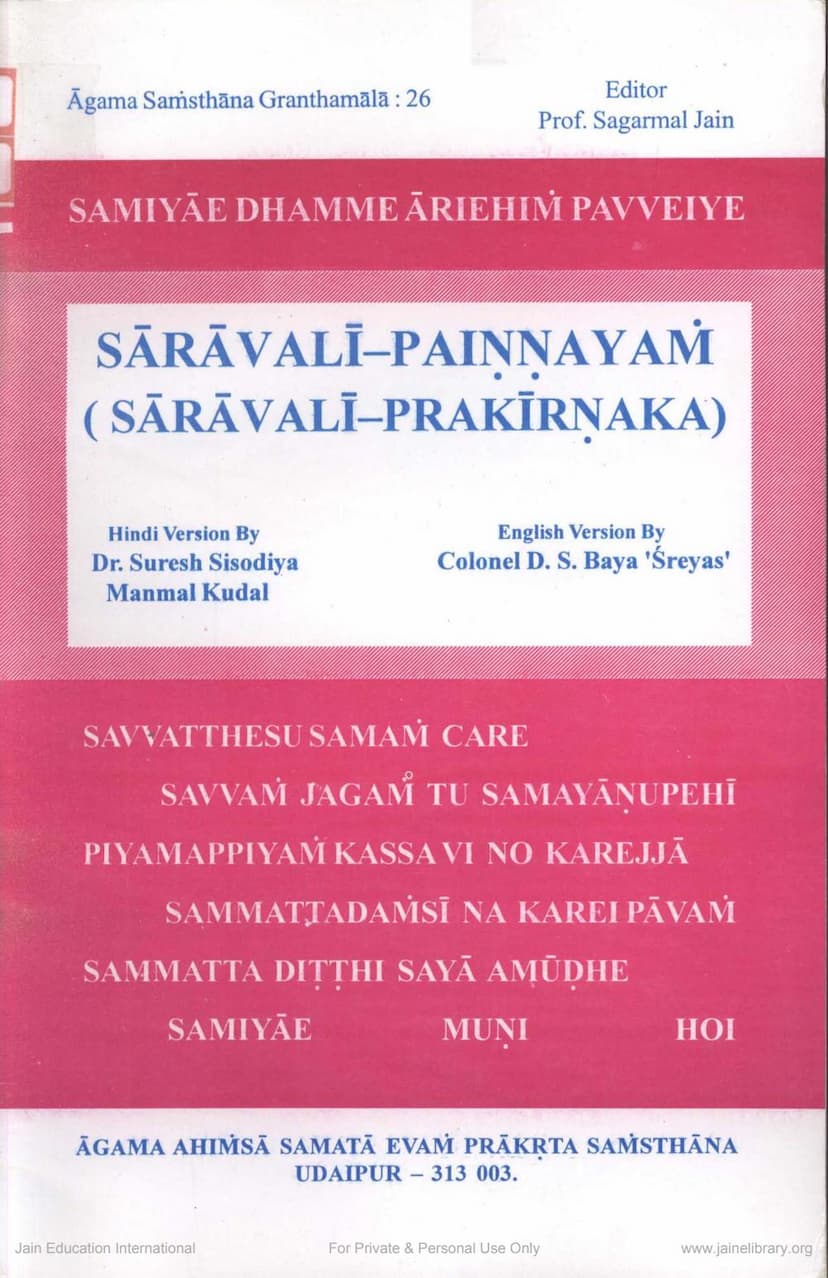Saravali Painnayam
Added to library: September 2, 2025

Summary
Here's a comprehensive summary of the Jain text "Saravali Painnayam" based on the provided pages:
Book Title: Saravali Painnayam (Saravali Prakirnaka)
Author: While the original author is unknown, Colonel D.S. Baya 'Śreyas' is credited with the English transliteration and translation. The original text was edited by Muni Śrī Punyavijayajī, and the Hindi version was translated by Dr. Suresh Sisodiya and Manmal Kudal.
Publisher: Agama Ahimsa Samata Evam Prakṛta Samsthana, Udaipur.
Nature of the Text:
- Prakirnaka: The book belongs to the "Prakirnaka" category within Jain canonical literature. Prakirnakas are considered miscellaneous or supplementary treatises.
- Focus on Pilgrimage: The "Saravali Painnayam" specifically focuses on the glorification and importance of Śatruñjaya hill, also known as Pundarikagiri, a significant Jain pilgrimage site.
- Narrative Style: The text is primarily a narrative that recounts the origin, naming, and significance of Pundarikagiri. It includes dialogues and teachings, most notably an exhortation by the omniscient monk Atimuktaka to Saint Narada.
- Spiritual Teachings: While emphasizing pilgrimage, the text also weaves in core Jain spiritual principles, such as the importance of the Pancha Parameshthi (five supreme beings), the transient nature of worldly life, the pain of existence, the benefits of charity and austerity, and the ultimate goal of liberation (moksha).
- Hagiography: It details the spiritual journeys and attainments of various souls, including monk Pundarika (after whom the hill is named), saint Narada, and numerous other monks and historical figures who achieved liberation at Śatruñjaya.
Key Themes and Content:
-
The Pancha Parameshthi: The text begins with an invocation and praise of the five supreme beings: Arihanta, Siddha, Ācārya, Upādhyāya, and Sadhu, highlighting their spiritual virtues and their revered status.
-
Origin and Glory of Pundarikagiri (Śatruñjaya):
- The narrative centers around the holy hill Pundarikagiri.
- The origin story involves Saint Narada inquiring from the omniscient monk Atimuktaka about the sanctity and naming of the hill.
- Atimuktaka explains that Pundarika, the grandson of the first Tirthankara Lord Rishabhadeva, attained omniscience and liberation there.
- The hill was named Pundarikagiri in his honor.
- Lord Rishabhadeva himself declared Pundarikagiri as the foremost pilgrimage site in the current era.
- The text describes the hill's physical attributes (height, width) and its divine beauty, adorned with various wish-fulfilling trees and pleasant scenery.
-
Significance of Pilgrimage and Devotion:
- Unparalleled Merit: The "Saravali Painnayam" strongly emphasizes that pilgrimage to Śatruñjaya yields immense spiritual merit, often surpassing what can be obtained through severe penance or charity elsewhere.
- Transformation: It highlights how devotion, remembrance, and actions at Śatruñjaya can transform individuals, bringing them wealth, happiness, favorable rebirths, and ultimately liberation.
- Accessibility of Merit: Even minimal acts of devotion, remembrance, or participation at Śatruñjaya are depicted as highly rewarding, making it accessible to all.
- Symbolic Importance: The text discusses the broader concept of "Tīrtha" (holy place or spiritual path) in Jainism, contrasting physical holy places with the "Bhava-tīrtha" (spiritual disposition). However, it clearly elevates Śatruñjaya as a supreme physical tīrtha due to its association with liberated souls and Tirthankaras.
-
Notable Attainments and Figures Associated with Śatruñjaya:
- Pundarika: The central figure who attained omniscience and liberation.
- Nami and Vinami: Vidyadhara kings who achieved liberation.
- Bharata: Emperor Bharata, son of Rishabhadeva, erected a temple at the site.
- Rama: Lord Rama attained enlightenment and liberation.
- Pandavas: The five Pandavas and their mother Kunti.
- Yadava Princes: Thirty-five million Yadava princes, including Pradyumna and Samba, attained omniscience and liberation.
- Dravidian Kings' Subjects: Fifty million people from Dravidian kingdoms also attained liberation.
- Saint Narada: Narrated the glory of the hill and later accepted ordination there.
-
Specific Practices and Rewards:
- Charity: Giving charity (flowers, jewels, gold, land, chariots) at Śatruñjaya brings immense rewards, including heavenly rebirths, kingship, and liberation.
- Austerities: Observing fasts and austerities at Śatruñjaya yields magnified results compared to other places.
- Worship: Performing worship in the temples on the hill is highly meritorious.
- Remembrance: Even remembering Śatruñjaya leads to spiritual progress and fulfillment of desires.
- Temple Construction: Building or maintaining temples on the hill grants significant spiritual and worldly benefits.
-
Historical Context and Authorship:
- The "Saravali Painnayam" is considered a later work, likely composed after the 14th century AD, as it is not mentioned in earlier canonical lists like the Nandisūtra and Pākṣikasūtra.
- Its language shows the influence of Apabhramśa, further suggesting a later period.
- The text is identified as part of the Svetambara tradition, specifically glorifying idol worship and pilgrimage.
Overall Significance:
The "Saravali Painnayam" is a significant Jain text that vividly portrays the spiritual importance and devotional value of Śatruñjaya (Pundarikagiri). It serves as a guide for pilgrims, detailing the merits and transformative power of visiting this sacred site. The text blends narrative storytelling with profound spiritual teachings, making it an influential work in Jain pilgrimage literature. The English translation by Colonel D.S. Baya 'Śreyas' makes this important text accessible to a wider global audience.